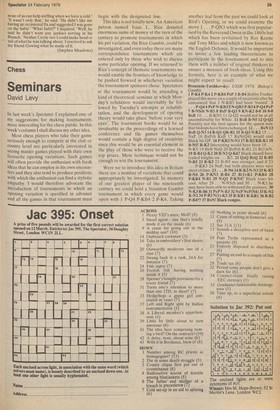Chess
Seminars
David Levy
In last week's Spectator I explained one of My suggestions for making tournaments more interesting for the chess public. In this week's column I shall discuss my other idea.
Most chess players who take their game seriously enough to compete at the club or county level are particularly interested in seeing master games played with their own favourite opening variations. Such games Will often provide the enthusiast with fresh Ideas that he can employ in his own encounters and they also tend to produce positions With which the enthusiast can find a stylistic empathy. I would therefore advocate the introduction of tournaments in which an Opening variation is specified in advance and all the games in that tournament must begin with the designated line.
This idea is not totally new. An American patron named Isaac L. Rice donated enormous sums of money at the turn of the century to promote tournaments in which his pet variation, the Rice Gambit, could be investigated, and even today there are many correspondence tournaments which are entered only by those who wish to discuss some particular opening. If we returned to Rice's concept of thematic tournaments we would enable the frontiers of knowledge to be pushed forward in whichever variation the tournament sponsors chose. Spectators at the tournament would be attending a kind of theoretical seminar at which Monday's refutation would inevitably be followed by Tuesday's attempts at rehabilitation, and the development of opening theory would take place 'before your very eyes'. The tournment books would be as invaluable as the proceedings of a learned conference and the games themselves would contain a high degree of creativity since this would be an essential element in the play of those who were to receive the top prizes. Mere technique would not be enough to win the tournament.
Were we to introduce this idea in Britain there are a number of variations that could appropriately be investigated. In memory of our greatest player of the nineteenth century we could hold a Staunton Gambit tournament in which every game would open with 1 P-Q4 P-KB4 2 P-K4. Taking another leaf from the past we could look at Bird's Opening, or we could examine the move 1 . . . P-QN3 which was first popularised by the Reverend Owen in.the 1860s but which has been revitalised by Ray Keene and Tony Miles and which is now known as the English Defence. It would be important to invite a few leading Theoreticians to participate in the tournament and to mix them with a number of original thinkers to ensure a measure of fresh ideas. Using this formula, here is an example of what we might expect to result.
Bronstein-Tseshkov;ky: USSR 1978, Bishop's Gambit.
1 P4(4 P4(42 P-KB4 PxP 3 B-B4 Bobby Fischer played this move on a couple of occasions after he announced that 3 N-KB3 had been 'busted'. 3
. P-Q4 4 PxP N-KB3 5 N-QB3 P-B3 6 P-Q4 PxP .13-N5ch N-B3 8 BxP B-Q3 9 KN-K2 0-0 100-0 BxB 10. . . B-KN5 11 Q-Q2 would not be at all uncomfortable for White. 11 RxB B-N5 12 Q-Q2 Possibly not the best square for the queen now that bishops have been exchanged. 12.. . BxN 13 BxB Q-N3 14 R-Q1 QR-RI 15 B-Q3 N-K 2 15 . . . NxP 16 BxPch KxB 17 RxN(Q4) would cost Black his OP. 16 P-KR3 N-N3 17 R-B2 KR-K! 18 B-N5! R-K2 Interesting would have been 18 . . . N-K5 19 BxR NxiD 20 BxPch K-RI 21 R(1)xN. 19 B-R4 Q-K3 20 B-N3 Q-K6? Black should have traded knights on . . . K5. 21 QxQ RxQ 22 R-B5 N-R5 23 R-K5 23 R-N5 was stronger, and if 23 . . . P-KR3 24 NxP, but both players were very short of time. 23. . . R-N6 24 R-K2 N-N3 25 K-R2 R-N4 26 P-KN3 R-B4 27 R(1)-K1 P-KR4 28 P-KR4 N-B! 29 N-Q1 P-KN4? Black loses his cool. After 29. . . N-N5ch and 30 . . . N-K3 he may have been able to withstand the pressure. 30 N-K3 R-B6 31 PxP N-K5 32 NxP NxP(N4) 33 K-N2 K-N2 34 P-B3 N(1)-K3 35 R-KR1 R-KR1 36 B-B2 P-B4?? 37 RxN! Black resigns.


































 Previous page
Previous page